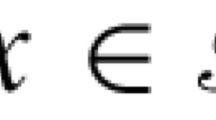Abstract
We first establish new point-based sufficient conditions for an implicit multifunction to achieve the metric subregularity. These conditions are expressed in terms of limit set critical for metric subregularity of the corresponding parametric multifunction formulated the implicit multifunction. We then show that the sufficient conditions obtained turn out to be also necessary for the metric subregularity of the implicit multifunction in the case, where the corresponding parametric multifunction is (locally) convex and closed. In this way, we give criteria ensuring the calmness for the implicit multifunction. As applications, we derive point-based sufficient and necessary conditions for a multifunction (resp., its inverse multifunction) to have the metric subregularity (resp., the calmness) and for the efficient solution map of a parametric vector optimization problem to admit the metric subregularity as well as the calmness.
Similar content being viewed by others
References
Robinson, S.M.: Generalized equations and their solutions. Part I: basic theory. Math. Program. Study 10, 128–141 (1979)
Dontchev, A.L., Rockafellar, R.T.: Robinson’s implicit function theorem and its extensions. Math. Program. 117(1–2), 129–147 (2009)
Dontchev, A.L., Rockafellar, R.T.: Implicit Functions and Solution Mappings. Springer Monographs in Mathematics. Springer, Dordrecht (2009)
Chuong, T.D., Kruger, A.Y., Yao, J.-C.: Calmness of efficient solution maps in parametric vector optimization. J. Glob. Optim. 51(4), 677–688 (2011)
Nghia, T.T.A.: A note on implicit multifunction theorems. Optim. Lett. 8(1), 329–341 (2014)
Chuong, T.D.: Metric regularity of a positive order for generalized equations. Appl. Anal. 94(6), 1270–1287 (2015)
Durea, M., Ngai, H.V., Tron, N.H., Strugariu, R.: Metric regularity of composition set-valued mappings: metric setting and coderivative conditions. J. Math. Anal. Appl. 412(1), 41–62 (2014)
Ledyaev, Y.S., Zhu, Q.J.: Implicit multifunctions theorems. Set Valued Anal. 7, 209–238 (1999)
Yen, N.D., Yao, J.-C.: Point-based sufficient conditions for metric regularity of implicit multifunctions. Nonlinear Anal. 70(7), 2806–2815 (2009)
Chuong, T.D., Kim, D.S.: Holder-like property and metric regularity of a positive-order for implicit multifunctions. Math. Oper. Res. 41(2), 596–611 (2016)
Durea, M., Strugariu, R.: Openness stability and implicit multifunction theorems: applications to variational systems. Nonlinear Anal. 75(3), 1246–1259 (2012)
Dien, P.H., Yen, N.D.: On implicit function theorems for set-valued maps and their application to mathematical programming under inclusion constraints. Appl. Math. Optim. 24, 35–54 (1991)
Chuong, T.D.: Lipschitz-like property of an implicit multifunction and its applications. Nonlinear Anal. 74(17), 6256–6264 (2011)
Huy, N.Q., Kim, D.S., Ninh, K.V.: Stability of implicit multifunctions in Banach spaces. J. Optim. Theory Appl. 155(2), 558–571 (2012)
Lee, G.M., Tam, N.N., Yen, N.D.: Normal coderivative for multifunctions and implicit function theorems. J. Math. Anal. Appl. 338, 11–22 (2008)
Yen, N.D., Yao, J.-C., Kien, B.T.: Covering properties at positive-order rates of multifunctions and some related topics. J. Math. Anal. Appl. 338(1), 467–478 (2008)
Burke, J.V.: Calmness and exact penalization. SIAM J. Control Optim. 29, 493–497 (1991)
Apetrii, M., Durea, M., Strugariu, R.: On subregularity properties of set-valued mappings applications to solid vector optimization. Set Valued Var. Anal. 21, 93–126 (2013)
Henrion, R., Outrata, V.: Calmness of constraint systems with applications. Math. Program. 104(2–3), 437–464 (2005)
Ioffe, A.D.: Necessary and sufficient conditions for a local minimum. 1: a reduction theorem and first order conditions. SIAM J. Control Optim. 17, 245–250 (1979)
Ioffe, A.D., Outrata, V.: On metric and calmness qualification conditions in subdifferential calculus. Set Valued Anal. 16, 199–227 (2008)
Ngai, H.V., Thera, M.: Error bounds in metric spaces and application to the perturbation stability of metric regularity. SIAM J. Optim. 19(1), 1–20 (2008)
Zheng, X.Y., Ng, K.F.: Metric subregularity and calmness for nonconvex generalized equations in Banach spaces. SIAM J. Optim. 20(5), 2119–2136 (2010)
Gfrerer, H.: First order and second order characterizations of metric subregularity and calmness of constraint set mappings. SIAM J. Optim. 21(4), 1439–1474 (2011)
Ngai, H.V., Tinh, P.N.: Metric subregularity of multifunctions: first and second order infinitesimal characterizations. Math. Oper. Res. 40(3), 703–724 (2015)
Ekeland, I.: On the variational principle. J. Math. Anal. Appl. 47, 324–353 (1974)
Clarke, F.H.: Optimization and Nonsmooth Analysis. Wiley, New York (1983)
Mordukhovich, B.S.: Variational Analysis and Generalized Differentiation. I: Basic Theory. Springer, Berlin (2006)
Rockafellar, R.T., Wets, R.J.-B.: Variational Analysis. Springer, Berlin (1998)
Aubin, J.-P., Frankowska, H.: Set Valued Analysis. Birkhäuser, Basel (1990)
Fabian, M.: Subdifferentiability and trustworthiness in the light of a new variational principle of Borwein and Preiss. Acta Univ. Carolin. Math. Phys. 30(2), 51–56 (1989)
Ioffe, A.D., Tihomirov, V.M.: Theory of Extremal Problems. North-Holland Publishing Co., Amsterdam (1979)
Acknowledgements
The author would like to thank the referees for the valuable comments and suggestions which have improved the final preparation of the paper.
Author information
Authors and Affiliations
Corresponding author
Additional information
Communicated by Regina S. Burachik.
Publisher's Note
Springer Nature remains neutral with regard to jurisdictional claims in published maps and institutional affiliations.
Dedicated to Professor Do Sang Kim on the occasion of his 65th birthday.
Rights and permissions
About this article
Cite this article
Chuong, T.D. Stability of Implicit Multifunctions via Point-Based Criteria and Applications. J Optim Theory Appl 183, 920–943 (2019). https://doi.org/10.1007/s10957-019-01562-3
Received:
Accepted:
Published:
Issue Date:
DOI: https://doi.org/10.1007/s10957-019-01562-3



